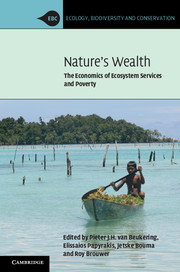Book contents
- Frontmatter
- Contents
- List of contributors
- Acknowledgements
- 1 The economics of ecosystem services and poverty
- Part I Biodiversity-related ecosystem services
- Part II Marine-related ecosystem services
- Part III Forest-related ecosystem services
- Part IV Water-related ecosystem services
- 12 Small-scale water harvesting and household poverty in northern Ethiopia
- 13 Water services, dam management and poverty in the Inner Niger Delta in Mali
- 14 The environmental and social impacts of flood defences in rural Bangladesh
- 15 Double dividends of additional water charges in South Africa
- Part V Land-related ecosystem services
- Index
- References
12 - Small-scale water harvesting and household poverty in northern Ethiopia
Published online by Cambridge University Press: 05 July 2013
- Frontmatter
- Contents
- List of contributors
- Acknowledgements
- 1 The economics of ecosystem services and poverty
- Part I Biodiversity-related ecosystem services
- Part II Marine-related ecosystem services
- Part III Forest-related ecosystem services
- Part IV Water-related ecosystem services
- 12 Small-scale water harvesting and household poverty in northern Ethiopia
- 13 Water services, dam management and poverty in the Inner Niger Delta in Mali
- 14 The environmental and social impacts of flood defences in rural Bangladesh
- 15 Double dividends of additional water charges in South Africa
- Part V Land-related ecosystem services
- Index
- References
Summary
Introduction
The climate of Tigray, northern Ethiopia, is mainly semi-arid and most of the region experiences erratic and inadequate rainfall that remains insufficient for crop production. Climatic change over the past decades has resulted in a temperature increase of about 0.2 ºC. This has resulted in a notable decrease in the amount of, and altered the distribution of, precipitation in Ethiopia (NMSA 2001). The distribution of mean annual rainfall over the country is characterized by large spatial variation and ranges from 2000 mm in some pockets in the south-west to less than 100 mm in the Afar lowlands in the north-east. Trend analysis of annual rainfall showed that rainfall levels remained more or less constant when averaged over the whole country while a declining trend has been observed over the northern half and south-western Ethiopia. The average annual minimum temperature has been increasing by about 0.25ºC while average maximum temperature has been increasing by about 0.1ºC every decade (NMSA 2001).
Climate change may have far reaching implications for Ethiopia for various reasons. The country’s economy depends mainly on agriculture, which is very sensitive to climatic variations. A large part of the country is arid and semiarid, and is highly prone to desertification and drought. Ethiopia has a fragile highland ecosystem, which is currently under stress due to population pressure. Forest, water and biodiversity resources of the country are also climate sensitive. Vector-borne diseases such as malaria, which are closely associated with climatic variations, affect Ethiopia. The country has experienced environmental problems such as recurring droughts, high rates of deforestation, soil degradation and loss, overgrazing, etc., which may be exacerbated by climate change. Climate change is, therefore, a case for concern (NMSA 2001). Assessing vulnerability to climate change and exploring adaptation options should therefore become a critical element of the development programme of the country. Among the possible adaptations to recurrent drought is the promotion of small-scale irrigation agriculture through small household-managed water harvesting structures.
- Type
- Chapter
- Information
- Nature's WealthThe Economics of Ecosystem Services and Poverty, pp. 265 - 282Publisher: Cambridge University PressPrint publication year: 2013



